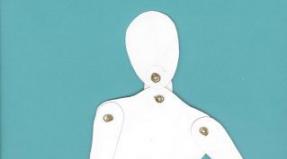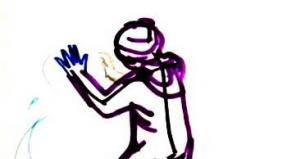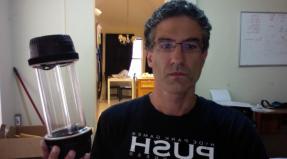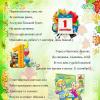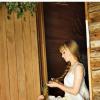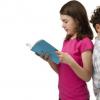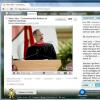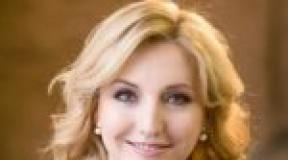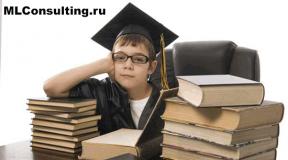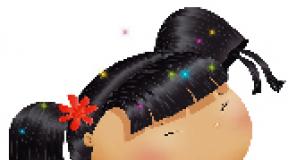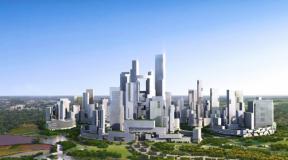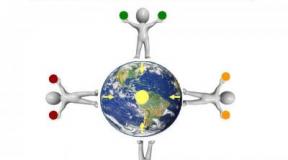Presentation on the world around on the topic "How a person moves" (Grade 4). Why does a person move and what are convulsions? II. Finding a Solution
1. Write which organs are protected by different parts of the skeleton.
Skull protects brain
The chest protects heart, lungs
The pelvic girdle protects excretory organs, intestines
The spine protects spinal cord
2. Arrange the names of the different parts of the skeleton (skull, lower leg, spine, foot, thigh) in the order in which the upper part rests on the lower.
3. Color the drawings of students acting wisely. Make signatures in the form of tips. 
Sit straight at the table, do not stoop! Don't forget to exercise in the morning! Move!
4. Explain the work of the muscles in the elbow joint. Write where the flexor muscles work, and where the extensors work.

5. Cross out the drawings in which the guys are doing wrong. Write smart advice.

Smart Tips: On the Run don't forget to look under your feet.Do not jump from a great height. If you feel a sharp pain, don't try endure but see a doctor urgently .
6. Work in pairs. One let him sign where walking is depicted, and where running. Let the second one complete the phrases and determine how they differ.

When walking at any given time, a person has at least one foot standing on the ground , and when running there are moments when a person does not touch the ground .
7. Why do people prefer to carry weights on their backs? (Insert the correct words.)
The muscles of the back and legs are developed better than arm muscles. After all, they have to keep the whole body in vertical (straight) position. That's why people prefer to carry weights on the back .
We move thanks to the muscles that cause the bones to bend and unbend. A person laughs or cries, sings or talks, walks at a slow pace or skips - all this is the “work” of the muscles.
The muscle can contract, that is, become shorter. To stretch it, you need to use another muscle that will “straighten” the first one. By contracting, the muscle moves the bone.
In order for it to return to its place, another muscle must contract.
Muscles are attached to bones by tendons, which are strong white fibers. The largest muscle is the gluteus. The one on which the person sits. Almost all tennis players have more developed muscles on the hand with which they hold the racket.
Muscles become larger if they are constantly trained, that is, given loads. That's why athletes and people who want to be strong spend a lot of time exercising.
What are seizures?
Cramps are involuntary muscle contractions. The muscle stops moving, as it always does, and seems to have hardened. It hurts. It is not yet known what causes cramps, but they pass if you rub the muscle hard or leave it alone for a while. Read our article.
How does a person move?
Human body
The topic of today's lesson is "How does a person move?". We will talk about the human musculoskeletal system, find out what parts it consists of.
Feel the palm of the left hand with the right hand. We will feel the muscles and bones. There are over 200 bones in the human body. They form the human skeleton, which is clad in muscles that make up almost half of the human body weight. If a person did not have bones and muscles, he would be soft, like a jellyfish, and would not be able to stand, move. The skeletal and muscular systems support the human body and help it move. This musculoskeletal system person. Consider the drawing of the skeleton, find out the names of its parts and their purpose (Fig. 1).
Rice. 1. Human skeleton ()
Parts of the skeleton: skull, spine, chest, ribs, pelvic bones, hand, thigh, lower leg, foot. Bones have two purposes: First, bones protect the vulnerable and soft organs of our body. For example, our skull, which is made up of strongly interconnected bones, serves as a reliable protective helmet for our brain (Fig. 2).

Rice. 2. Human skull and brain ()
Spine made up of small bones vertebrae(Fig. 3).
Rice. 3. Vertebra ()
There is a small hole in the middle of each vertebra, and since the vertebrae are located one above the other, the holes are located one under the other and a long channel is formed inside the spine, in which spinal cord(Fig. 4).

Rice. 4. Spinal cord ()
The spine protects the spinal cord inside it, which is a thick bundle of nerves, and a strong rib cage from the ribs protects our heart and lungs (Fig. 5).

Rice. 5. Chest ()
The second purpose of the bones: the spine and leg bones, together with the skeletal muscles and joints, enable a person to stand and walk. Joint is a movable joint of bones.
In order to feel what the muscles are like to the touch, you can, for example, take the upper part of the right hand with the fingers of the left hand and bend and unbend the arm at the elbow several times. Interestingly, the title muscles"comes from the word muscle, What means " mouse» (Fig. 6).

Rice. 6. Human muscles ()
To scientists who studied the structure of the human body, muscle contraction resembled the running of a mouse under the skin. They counted more than six hundred muscles in the human body. Muscle tissue is made up of cells. The muscle cell is long, narrow and resembles a fiber. Thus, during flexion and extension of the arm, the skeletal muscle is attached to one end of the bone and stretches along its surface. It then passes through the joint and attaches to another bone, pulling on the bones to which it is attached. Muscles can stretch (lengthen) and contract (become shorter).
Consider the drawings of a bent and unbent arm at the elbow joint (Fig. 7).

Rice. 7. Drawings of the arm bent and unbent at the elbow joint ()
Let's find the flexor muscle, the extensor muscle and their places of attachment. The flexor and extensor muscles are two opposing mechanisms that work in concert. If the flexor muscle contracts, then the extensor muscle relaxes, and vice versa. This allows us to perform various movements with our hands: write, draw, knit, build, pull up on the horizontal bar, etc. And the muscles of the back and legs are more massive than the muscles of the arms, because they have to keep the whole body in an upright position. But, of course, the spine plays a significant role in this.
The spine can withstand large loads in an upright position, however, even the smallest loads experienced by the spine with incorrect posture can lead to its curvature. With incorrect posture in a child who sits or works in the wrong position every day, the spine, which grows with the body, begins to bend, unable to withstand the weight of the body (Fig. 8).

Rice. 8. Incorrect posture of the child ()
In order to avoid curvature of the spine, you must first of all monitor your posture, do not stoop. You can check the correctness of your posture in this way: you need to stand up to the closed door so that the back of the head, shoulder blades, heels and tips of the little fingers, lowered and pressed to the body, hands touch the surface of the door (Fig. 9).

Rice. 9. Checking the correct posture ()
Standing for such a long time is difficult, but it is one of the simple physical exercises that can be performed every morning for about five minutes not only by a child, but also by an adult. Correct posture is not given to us from birth, it is developed throughout life (Fig. 10).

Rice. 10. Correct posture ()
An interesting fact is that human bones are made up of living cells. Like all living cells, bone cells can divide. Everyone knows that in a person, after a fracture of an arm or leg, the bones grow together. If the bone tissue did not consist of living cells, this would not happen. And with the growth of the child, the thickness and length of the bones increase, and adults do not grow because they do not have cartilage. A feature of the skeleton of children is cartilage, which is much softer than bones. Cartilage has the magical ability to turn little ones into big ones. In the first weeks of a child's life, his skeleton is almost entirely cartilaginous. Cartilage is soft, flexible, fragile, and can be easily damaged. The child's skeleton is growing rapidly, and gradually separate islands of real hard bone appear in the cartilaginous tissue. Bone areas increase over the years, while cartilaginous areas decrease, and this, in the end, leads to a delay in their growth (Fig. 11).

Rice. 11. Change of bones with age ()
Like any cell in the human body, bone cells need blood to bring them oxygen and nutrients. Blood enters the bone cells through blood vessels that pass through special openings (Fig. 12).

Rice. 12. The structure of the bone ()
Interestingly, many bones have a cavity inside, thanks to which the bones are so light. Inside the cavity of the bone is the bone marrow (Fig. 13),

Rice. 13. The structure of the bone ()
which produces blood cells: red blood cells that carry oxygen (Fig. 14),

Rice. 14. Red blood cells ()
and white blood cells, which help our bodies fight germs and disease (Figure 15).

Rice. 15. White blood cells ()
Today at the lesson we talked about the human musculoskeletal system and found out the purpose of the musculoskeletal system.
Bibliography
- Vakhrushev A.A., Danilov D.D. World around 3. - M.: Ballas.
- Dmitrieva N.Ya., Kazakov A.N. The world around 3. - M .: Publishing house "Fedorov".
- Pleshakov A.A. The world around 3. - M .: Education.
- Festival.1september.ru ().
- Ucheba-legko.ru ().
- Anatomus.ru ().
Homework
- Prepare a short presentation about the human musculoskeletal system and discuss it with the school teacher.
- Draw the human skeleton and label its parts.
- * Make a crossword puzzle about the human musculoskeletal system.
Technological map of the lesson around the world
Lesson topic: " How a person moves.
The purpose of the lesson: To form new anatomical and physiological concepts about the importance of the musculoskeletal system, about the structure and features of the human skeleton, about the joints, the properties of bones, the main muscle groups, about the work of muscles.
PLANNED LESSON OUTCOMES:
Metasubject (developing):
- Communicative:the ability to listen and understand others; build a speech statement in accordance with the tasks; formulate your thoughts orally; ability to work in pairs and in groups.
- Regulatory: the ability to express their own assumptions based on work with the material of the textbook; evaluate learning activities in accordance with the task; predict upcoming work (make a plan.).
- Cognitive: the ability to extract information from diagrams, illustrations, texts; present information in the form of a diagram; identify the essence, features of objects; draw conclusions based on the analysis of objects; generalize and classify according to features.
Subject (educational):to reveal new anatomical and physiological concepts about the importance of the musculoskeletal system, about the structure and features of the human skeleton, about the joints, the properties of bones, the main muscle groups, about the work of muscles.
Personal (educational):the ability to express their attitude towards the characters;
Express your emotions; evaluate actions in accordance with a certain situation; we form motivation for learning and purposeful cognitive activity.
Main methods:visual, verbal, practical, control, self-control.
Forms of organization of cognitive activity of students:frontal, group.
Equipment: multimedia projector, textbook, workbook.
Board layout:
Presentation |
Lesson plan:
Lesson stage | Regulations |
|
Org.moment | ||
Knowledge update | ||
Statement of the problem of the lesson | 5 - 7 |
|
Introduction of new knowledge | ||
Primary consolidation of knowledge | ||
Summary of the lesson. Reflection |
Stages | Activities of the teacher and students | Formed UUD |
Org. moment | Hello guys! Let's start our lesson by saying: "One mind is good, but two is better." How do you understand this statement? Today in the lesson we will try to make a new discovery. Wish you luck! Recall the two steps of learning activity. How do we start the lesson? (From repetition.) | Cognitive UUD We develop the ability to extract information from diagrams, illustrations, texts. Present information in a diagram. Reveal the essence, features of objects. Draw conclusions based on the analysis of objects. Summarize and classify according to features. Communicative UUD We develop the ability to listen and understand others. Build a speech statement in accordance with the tasks. Express your thoughts orally. Ability to work in pairs and in groups. Personal Outcomes We develop the ability to express our attitude towards the characters, Express your emotions. Evaluate actions in accordance with a certain situation. We form motivation for learning and purposeful cognitive activity. Regulatory UUD We develop the ability to express our assumption on the basis of work with the material of the textbook. Evaluate learning activities in accordance with the task. Predict Future work (make a plan.) |
Knowledge update | What is an organ system? (The human body consists of groups of organs. A group of organs connected to each other and jointly performing a common task in the body is called an organ system.) What systems are we familiar with? What is the musculoskeletal system made of? (From the skeleton and muscles.) |
|
Statement of the problem of the lesson | Read Lena's words on page 16. What opinions did she make? (How do we walk?) What contradiction did you notice in her words? (The human body cannot rest on muscles, and rigid bones hinder movement.) What do we know to answer this question? How do animals move? What organs are involved in their movement? (Animals have special organs for movement: fins for fish, limbs for animals, wings for birds. When moving, animals rely on the environment in which they live.) - What kind of skeleton does animals have? Give examples. (The skeleton is external, for example, in insects, and internal, in fish, amphibians, and other animals.) What groups of substances can be found in living organisms? How do they get there? (Organic and mineral substances. Organisms receive them during nutrition and respiration.) What is the human musculoskeletal system made of? (From the skeleton and muscles.) What role does this system play in the human body? (Helps move, protects internal organs, provides support for the body.) - What will be discussed in the lesson today? What is its theme? (how a person moves) |
|
Introduction of new knowledge | - Let's get acquainted with the structure of the human skeleton in more detail. (Assignment to the drawing on p. 17.) What parts can be distinguished in the human skeleton? What are these parts made of? What is the significance of these parts of the skeleton? - What is the main role of the entire skeleton? (Reference.) - If the skeleton plays the role of a support, then what properties should the bones that form it have? (The bones must be strong, strong, rigid.) Let's check your versions with the textbook. Pictures on p. 16. The tibia in a vertical position can withstand a load of 1500 kg, although its mass is only 0.2 kg. “If bones are so strong, why do fractures happen?” (Fractures occur when the load on the bones of the skeleton is not properly distributed.) Task 3 on p. 6 workbooks. Carry out the task. Why does curvature of the spine occur? (Due to incorrect body position, for example, at a desk.) How are bones connected to each other? To answer this question, make an observation:
- Look at the picture on p. 18: How are the bones of the skull connected? - Compare your observations. Try to explain them (versions, check with the text of the textbook). - The bones of the skeleton are connected movably or semi-movably. Such a connection gives a person the opportunity to move freely. The bones of the skull are connected motionless, as they protect the brain. - If the musculoskeletal system consisted of only one skeleton, would we be able to move? (No, because the bones are hard.) - To find out the role of muscles in the body, let's make an observation: bend your arm at the elbow and find the muscles. Determine by touch what they are, how they behave when bending and unbending the arm. Muscles have two main qualities: elasticity and excitability. Elasticity allows them to lengthen and shorten. A relaxed muscle is soft, a working muscle is hard. And excitability makes the muscles particularly sensitive to nerve impulses and external stimuli, such as injections, changes in ambient temperature. There is such a state of the muscles as muscle tone. It is a slight muscle tension during rest. This tension allows you to support the body when you are still and resting. Let's make a conclusion. Perform tasks, design a joint. How will we answer the question of the lesson? (Muscle contraction changes the position of the bones. This is how we move.) |
Lesson 3 How does a person move
Goals:
To form new anatomical and physiological concepts about the importance of the musculoskeletal system, about the structure and features of the human skeleton, about the joints, the properties of bones, the main muscle groups, about the work of muscles.
During the classes:
REMEMBER WHAT WE KNOW
Question 1. What kind of skeleton do animals have?
The skeleton is external, for example, in insects, and internal - in fish, amphibians and other animals.
Question 2. How do animals move?
In multicellular animals, the main organs that set the body in motion are the muscles. Their ability to actively contract and passively stretch is acquired through muscle contraction or even under the weight of an organ. If the animal has a rigid skeleton, it must have movable joints for movement. Active movement in space is provided by special organs of movement, with the help of which the animal is repelled from the external environment: from water when swimming, from the surface of the earth on land or from the bottom of a reservoir, from the air when flying.
SOLVE THE PROBLEM, DISCOVER NEW KNOWLEDGE
Consider musculoskeletal system . It consists of a skeleton and muscles ...
Skeleton It is the basis, the support of our body. It is on the size of the skeleton that the dimensions of the human body depend on more than 200 different bones (!)
Bones are very strong, they are composed of organic and mineral substances. However, with unsuccessful falls and loads, bone fractures occur.


1 - brain skull, 2 - facial skull, 3 - bones of the girdle of the upper limb, 4 - humerus, 5 - bones of the forearm, 6 - bones of the hand, 7 - chest 8 - spinal column, 9 - bones of the belt of the lower extremities, 10 - femur, 11 - leg bones, 12 - foot bones.

All bones of the skeleton are divided into subgroups:
Axial skeleton
Scull - the bone base of the head, is the seat of the brain, as well as the organs of vision, hearing and smell. The skull has two sections: cerebral and facial.

Additional skeleton
- Upper limb belt - provides attachment of the upper limbs to the axial skeleton. Consists of paired shoulder blades and clavicles.
- upper limbs
- best adapted to work. The limb consists of three sections: shoulder, forearm and hand.

- Belt of the lower extremities - provides attachment of the lower limbs to the axial skeleton.
- lower limbs
- adapted to move the body in space.

The bones are connected to each other. Where they do not move, for example in the skull, a motionless compound . In mobile organs, such as the arm, the bones are movably held together. Such a movable connection of bones is called joint .
Knee-joint

Interesting Facts:
- At birth, a baby's skeleton has 300 bones. With age, their number decreases to 206. This anatomical "strangeness" has a simple explanation. Some bones are made up of several compound bones that fuse together to form one.
- In the morning we are 1 cm taller than in the evening. The cartilage that connects the bones is more affected by the law of universal gravitation. As a result, during the day they shrink, “thanks to” which by the evening we lose up to 1 cm in height.
The longest bone is the femur, its length is usually 27.5% of a person's height. The shortest is the stirrup, which is located in the inner ear. Its length is only 3-4 mm.
The legs are 25% of all bones. You may not take much care of your feet. But it is the foundation of our health. They bear the brunt, both literally and figuratively. Of the 200 bones, 52 are in the legs.
Online skeleton. .
"Why Am I Standing Straight" episode of the animated series "The Adventures of Adibu" (from 0:40)
muscles able to contract and set our body in motion. It is impossible to accurately specify the number of muscles. Specialists count from 400 to 680 muscles in a person. For comparison: grasshoppers have about 900 muscles, some caterpillars have up to four thousand.

Muscles can contract and relax. A relaxed muscle is long and soft; a contracted muscle is short and hard. Muscles are attached to bones by tendons. Muscle contraction sets bones in motion.
The bend of the arm in the elbow joint depends on two oppositely working muscles.

Interesting Facts:
- The smallest muscle is the stirrup muscle.
- When we smile, we use 17 facial muscles. And in order to express disapproval - 43! So, smiling is not the best way to get the maximum number of muscles working. Smile just like that when you are sad or funny.
- The strongest muscle in the human body is the tongue. But it's not just about strength, it's also about endurance. Think about it, you do not pay attention to the fact that you use your tongue all day during negotiations, at breakfast, lunch and dinner, when you swallow, etc. We are so confident in the performance of this muscle that we do not even allow the thought that it can fail.
- To take "one small step for man, but a giant leap for all mankind" you need to use 200 muscles.
"Why I Move" episode of the animated series "The Adventures of Adibu" (from 0:43)
Why Muscles Grow
Muscle contraction changes the position of the bones that are movably connected at the joints, allowing a person to move.
POSSIBLE ANSWERS TO THE WORKBOOK
Task 1. Workbook page 6
Task 2. Workbook page 6
Task 4. Workbook page 6
Task 5. Workbook page 7
Task 7. Workbook page 7
YOU ARE NOW READY TO DO THE HOMEWORK IN THE WORKBOOK. GOOD LUCK!
Read also...
- The history of the invention and development of watches The history of the transformation of watches
- Why does a person move and what are convulsions?
- How to decorate the room in an original way for the holiday: do-it-yourself birthday posters
- What are synonyms and antonyms in Russian What are called antonyms give examples
